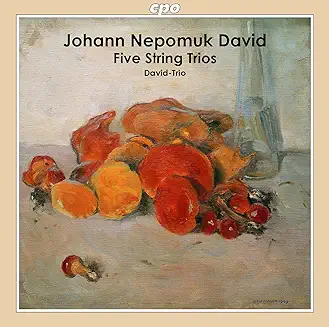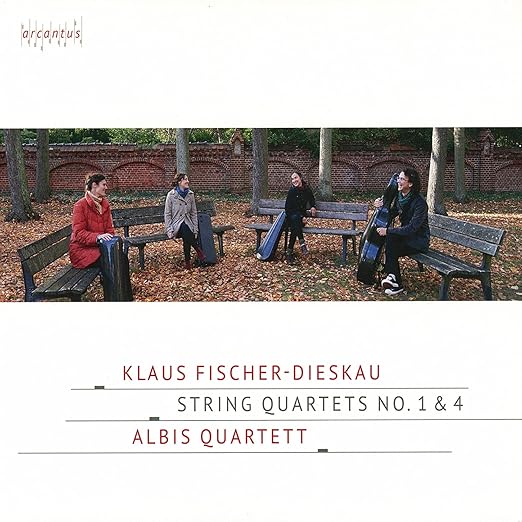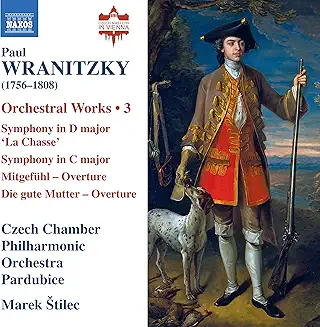David, J.N.: Five String Trios (G major & Op. 33 Nos. 1-4); OÖ. David-Trio [CPO]
Some years ago we told you about four of Austrian composer Johann Nepomuk David's (
1895-1977) eight symphonies on CPO (see
23 June 2014 and
31 July 2018). Now that adventurous label gives us his five string trios, each of which has three-movements. They're all the more colorful for the composer's skillful use of special string effects (e.g.,
glissando,
pizzicato,
tremolo,
trill) in addition to
string harmonics as well as
tapping and
bowing techniques.
Proceeding chronologically, the
String Trio in G major (1931) is a reworking of two earlier, identically scored pieces bearing the name
Sonatine, which were written in 1928 and 1929. That said, David's
allegretto (
lively), sonata-form first movement [T-13] is a
late-Romantic dish with
chromatic spicing, and may bring to mind the opening one from German composer Max Reger's (
1873-1916) last effort in the genre (
1915).
Its opening statement has two ideas that are respectively songful (SF) [00:01] and yearning (YR) [00:37]. Then (YR) initiates a vivacious, two-part development of the foregoing [00:48 & 01:42]. This is followed by a pause and SF-initiated, nervous recap [02:13], having a YR-based coda [02:56] that ends the movement with a pizzicato pluck.
The subsequent "Moderato" [T-14] is a four-part
passacaglia [00:01, 01:43, 02:58 & 03:21] with a devout, YR-reminiscent
ostinato heard at the outset. It's a reverent respite before the
allegretto leggiero (
lively and nimble) marked closing movement.
This is a theme-and-variations-like
canon based on an opening, SF-reminiscent perky thought (SP) [00:01]. Accordingly, SP undergoes several treatments that range from whimsical [00:51] to headstrong [01:17], feline [02:05] with a flighty midriff [03:04-03:25], and forceful [04:18]. Then a subdued, SF afterthought [04:27] ends the work unassumingly.
Not long after World War II (WWII,
1939-45) David would write two more string trios (1945), and yet another pair of them some three years later (1948). These immaculately crafted works, which are grouped as his Op. 33, fill out this release. Incidentally, the composer dedicated each to a different, famous
luthier. Moreover, the first honored Nicolò Amati (
1596-1684), while the next three paid homage to Antonio Stradivari (
1644-1737), Giuseppe Guanieri (
1698-1744) and Jacob Stainer (
1619-1683) respectively.
His Op. 33 No. 1 of 1945 has a sonata-form, first movement marked
allegro deciso (straffe Halbe) (
decidedly fast (taut half notes)) [T-1]. Its opening statement has a brief, lively preface hinting at a whimsical first theme (WM) that soon appears [00:08 & 00:26]. Then WM bridges into a complementary second thought (WC) [01:00], and initiates a capricious development [01:19] followed by a brisk recapitulation [03:48] that ends the movement expeditiously.
The next one [T-2] begins
adagio (langsam fließend Halbe) (
slow (slow fluent half notes)) with a sad theme (SD) [00:01] that's cause for a pensive contemplation. However, after a brief pause the music suddenly shifts gears and we get an
allegro leggiero (
fast and nimble), mercurial version of ST (MC) [02:39]. MC powers "scherzoesque" passages that seemingly end, but soon resume at a frenetic pace [03:09], thereby concluding this
Janus-like creation with a big grin.
Then there's an
allegretto (
lively), fugal last movement [T-3] based on a WF-WC subject (FC) [00:01]. As the music proceeds, FC undergoes some melodic alterations. These include
inversion as well as
augmentation. The latter appears towards the end in the cello part [beginning at 02:30] and is marked
stark gezogen (
strongly drawn). It underlines the closing measures, which end the work with a perfunctory, pizzicato plunk.
Moving right along there's the Op. 33 No. 2 (1945). Like No. 1 there's a sonata-form first movement [T-4], but this time around the marking is
Gemächliche Viertel, fließend (
leisurely quarter notes, fluent). Here an aloof first theme (AF) [00:02] is followed by a chatty second (CT) [00:58], which initiates a peripatetic development [01:21] involving both. This becomes increasingly distraught and gives way to a pause. Then an
augmented AF [04:12] invokes a
canonesque recapitulation that waxes and wanes, bringing the movement to a tranquil conclusion.
It's followed by a tragic
Adagio (langsame punktierte Vierte) (
Slow (dotted quarter notes)) [T-5] that begins with a wistful version of AF [00:01]. This is the subject of three gloomy treatments [02:21, 03:49 & 04:58], the last of which ends things uneventfully.
The mood brightens with the concluding
Allegro energico (Halbe) (
Fast and energetic (half notes)) [T-6], which is of
sonata-rondo disposition and begins with a playful version of AF (AP) [00:01]. AP is the recurring idea for captivating developmental passages [00:48]. These come to a brief pause, making you think this piece has ended. But then an invigorated AP [04:15] launches a recapitulative episode that brings it to an expeditious conclusion.
Three years later, the composer wrote the two remaining trios in this series, his Op. 33 No. 3 (1948) being our next selection. It's first movement [T-7] has a pensive,
adagio (
slow) introduction [00:02] hinting at things to come. Then the music becomes
allegro moderato (
moderately fast) with a three-part, developmental
passacaglia [01:35, 03:09 & 05:46]. This has an
ostinato that's a chorale-like idea (CR) [01:35], and ends the movement uneventfully.
Bearing the lengthy marking
allegro leggierissimo, so leicht und rasch als ausfuhrbar (
very light, as easily and quickly as possible), the second one [T-8] is a scherzo with frenetic,
stretto-laced, CR-tinged, outer sections [00:01 & 02:56]. They surround a relaxed CR-reminiscent trio [01:57-02:55], which brings to mind a troubadour serenading his ladylove, and the last one closes things with an anguished outburst [04:15].
The hectic pace set above continues in the closing
Allegro (
Fast) [T-9]. This begins with our old friend CR [00:01], which immediately becomes the main subject for a magnificent fugue that transitions into some variational treatments of CR. These range from subdued [03:35] to highly agitated [03:53], nostalgic [04:02] and busy [04:27], where the last ends the trio with a sudden
fff chord for all [05:15].
Turning to the next, it's the companion Op. 33 No. 4 (1948), which is a thematically convoluted piece of work (see the detailed album notes). Suffice it to say the initial
Vivo (Heftig voran, aber nicht hasten) (
Lively (Vigorously forward, but not rushed)) [T-10] gets off to an agitated start [00:02], soon followed by more laid-back back passages [01:16] that evoke an austere theme (AT) [01:29].
AT undergoes an exploration, which turns increasingly troubled [02:37] with a variety of colorful string effects along the way. Then the music suddenly takes on a subdued disposition with the return of AT [04:07]. This triggers memories of the opening measures [05:08] that close the movement definitively.
Stylistically speaking, the second one [T-11] is a combination passacaglia and theme with variations, which falls into three sections. The opening
adagio (
slow) one begins with an "upside down" version of AT (AU) [00:01] that's rather gloomy and serves as an
ostinato as well the main subject for what's to come.
AU is subsequently contemplated, initiating an
andante (
flowing), anguished section [02:25-04:45]. Then it returns parenting an
adagio (
slow) third one [04:48], thereby ending this mongrel movement in quiet desperation.
Ennui turns to excitement in the last
allegro deciso (
decidedly fast) one [T-12]. It's a
double fugue, whose first subject is an AT-reminiscent, busy, insistent ditty [00:01] soon followed by a related, more tranquil second [02:08]. Then both ideas are skillfully bandied about, and conclude the trio forcefully.
All five selections are performed by the Ober Österreichisches David Trio (Upper Austrian David Trio), which was established in 2002 on the 25th anniversary of the composer's death. Consisting of violinist Sabine Reiter, violist Peter Aigner and cellist Andreas Pözlberger, these talented musicians deliver totally committed, technically accomplished, yet highly sensitive accounts of everything here. They give us some very welcome additions to the rather small body of works in this genre.
The recordings were made a couple of years ago at the Anton Bruckner Privatuniversität (
Anton Bruckner Private University)
Music Hall located in Linz, Austria, some 100 miles west of
Vienna. They consistently present an appropriately sized sonic image with the instruments centered from left to right in order of increasing size, and well balanced against one another.
The string tone is very natural. More specifically, it's characterized by pleasant highs as well as a rich midrange on top of clean lows, where there's no hint of boominess in the cello's lower registers. What's more, the overall sound is all the richer for this magnificent venue, and as good as it gets on conventional CDs. Consequently, this release earns an "Audiophile" rating.
--
Bob McQuiston, Classical Lost and Found (CLOFO.com, Y220131)








